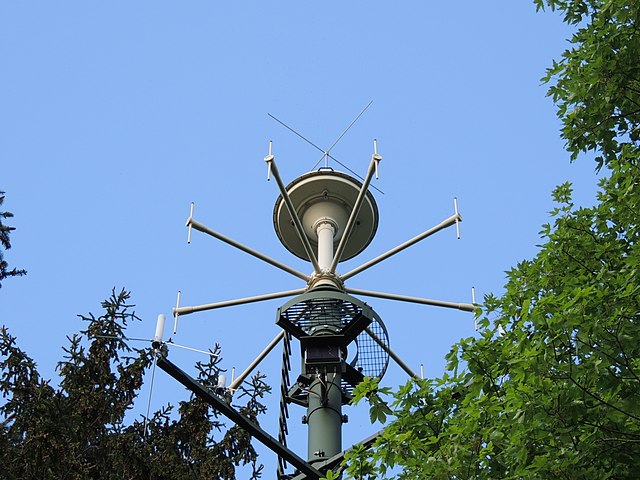Circularly disposed antenna array
A circularly disposed antenna array (CDAA), sometimes referred to as a circularly disposed dipole array (CDDA) or a wullenweber, is a large circular antenna array used for radio direction finding. They are used by military and government agencies to triangulate radio signals for radio navigation, intelligence gathering, search and rescue, and enforcement of broadcasting laws. Because their huge circular reflecting screens look like circular fences, some antennas have been colloquially referred to as "elephant cages". The term "wullenwever" was the World War II German cover term used to identify their secret CDAA research and development program; its name is unrelated to any person involved in the program.
Direction-finding system Galeta Island, Panama
CDAA at US Navy Sobe Communications base, Yomitan, Okinawa, Japan
An overhead view of Elmendorf AFB, Alaska, in late 2002. The antenna array is the large circle in the forested area, in the upper left, comparable in size to the adjacent airstrip.
Direction finding (DF), or radio direction finding (RDF), is the use of radio waves to determine the direction to a radio source. The source may be a cooperating radio transmitter or may be an inadvertant source, a naturally-occurring radio source, or an illicit or enemy system. Radio direction finding differs from radar in that only the direction is determined by any one receiver; a radar system usually also gives a distance to the object of interest, as well as direction. By triangulation, the location of a radio source can be determined by measuring its direction from two or more locations. Radio direction finding is used in radio navigation for ships and aircraft, to locate emergency transmitters for search and rescue, for tracking wildlife, and to locate illegal or interfering transmitters. During the Second World War, radio direction finding was used by both sides to locate and direct aircraft, surface ships, and submarines.

Radiotriangulation scheme using two direction-finding antennas (A and B)
Direction finding antenna near the city of Lucerne, Switzerland
W.G. Wade of the National Bureau of Standards uses a large multi-loop antenna to perform RDF in this 1919 photo. This is a fairly small unit for the era.
This Royal Navy model is typical of B–T goniometers. The two sets of "field coils" and the rotating "sense coil" are visible.







